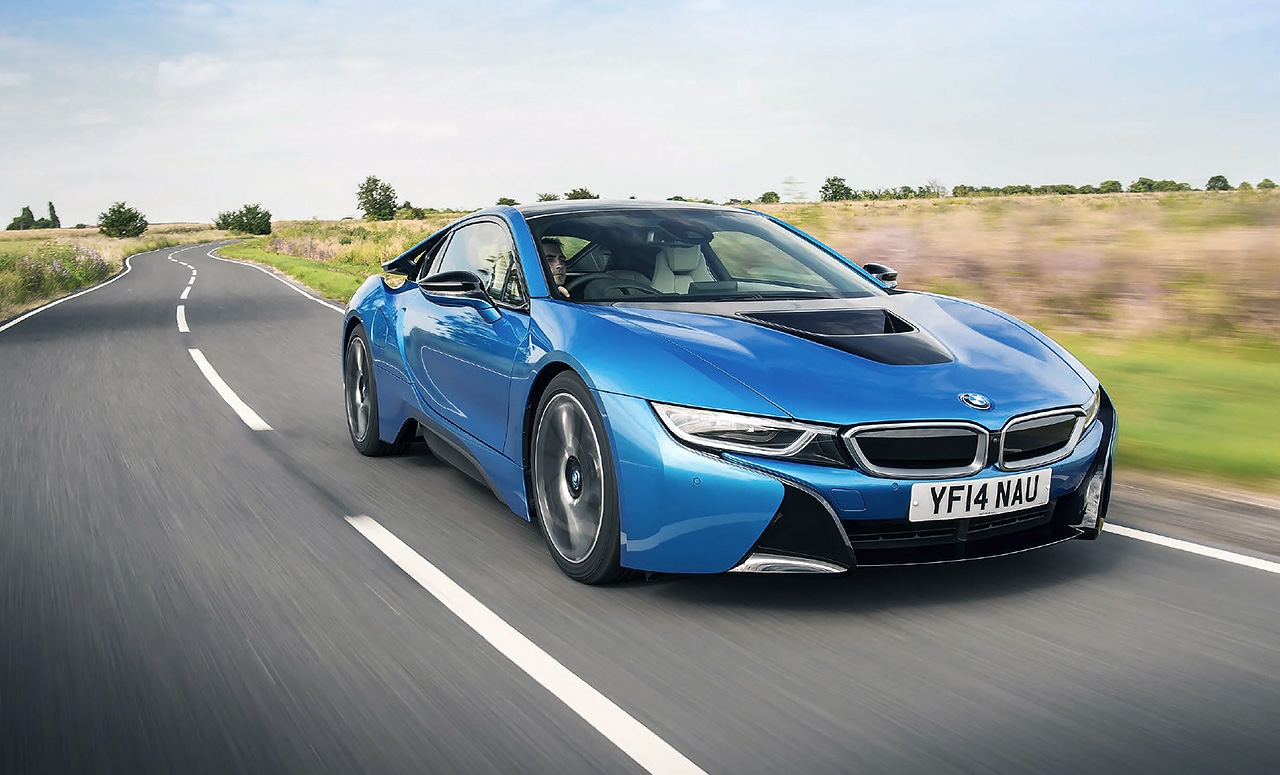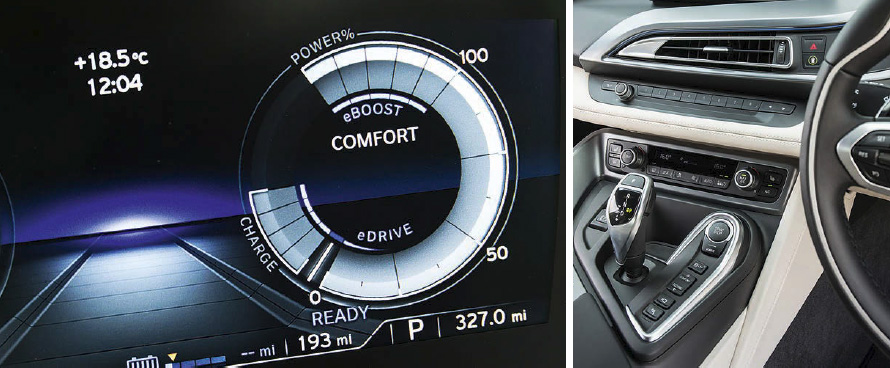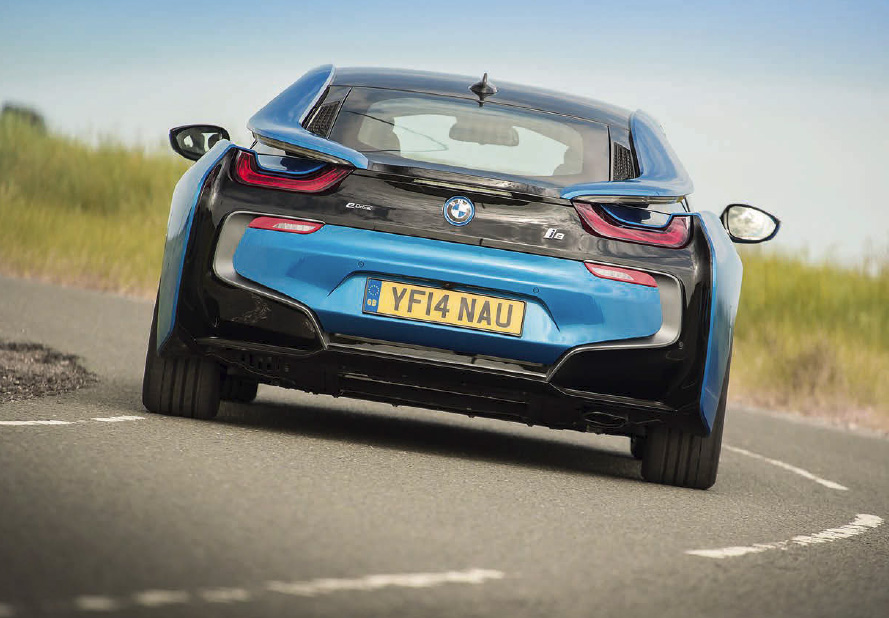
Game changer. The BMW i8 is finally here in the UK and the first drive certainly left a lasting impression on us. We were blown away by the i8 on the international launch but does the car’s wow factor translate onto the UK’s roads? We travelled to Scotland to find out. Words: Bob Harper Photography: BMW.
I should probably whisper this, but I don’t really get supercars. It’s not something you’re really meant to admit when one’s a motoring journalist but as far as I’m concerned you can keep your Bugattis, Koenigseggs and modern Lamborghinis – they just don’t float my boat. I’d be much more inclined to sink my money into a classic supercar – show me an M1, Miura or a 365 Berlinetta Boxer and I tend to go a little weak at the knees – and as for the latest generation of million-pound hybrid machinery from the likes of Porsche, McLaren and Ferrari, they just seem to be ridiculously overhyped and overpriced.

So why is it that I’m champing at the bit to dive into the cockpit of one of the i8s that are basking in the unexpected sunshine that’s currently gracing Inverness airport? It’s a machine I’ve wanted to drive ever since I first saw the Vision EfficientDynamics Concept that started doing the motor show rounds back in 2009 and the main reason for this is that I simply love the way it looks. I’m still stunned that BMW made the decision to build it, doubly so as it still looks so dramatic, even if some of the styling has been sanitised for the production version.

Either way it’s still a jaw-droppingly gorgeous machine and the drama of the shape is even more pronounced now that you can see the car out of the false surroundings of the motor show pedestal. In amongst other vehicles it really does look a little bit like it’s been dropped in from the set of the latest futuristic sci-fi film. Everyone will have their own opinion on the styling but for me it’s virtually perfect and I don’t think there’s an angle, curve or line on the car that I don’t like. From its dramatic headlights to its horseshoe-shaped rear lights and wild flying buttresses, I absolutely adore it.

BMW has whisked us off to Scotland to sample its latest, and perhaps greatest, creation on some of the country’s finest driving roads but before we can clamber into the driver’s seat we have a brief press conference and once that’s completed we’re handed a set of keys and told to go and enjoy ourselves. From the press briefing it’s obvious that there’s more technology packed into this car than the rest of the range put together so before heading off to put it through its paces it’s time to take stock of the cockpit and controls.

Entry to the i8 is no less dramatic that the way the car looks with the large but exceedingly light doors scissoring open after you’ve flicked the catch hidden in the cavity behind the door. There are shades of BMW Z1 about getting into the cabin as there’s a very high carbon sill to be negotiated and if you were wearing a short skirt or on the elderly side you might struggle somewhat to complete the manoeuvre with a measure of decorum, but once you’ve got in and out a couple of times you’ll have worked out how to do it without making a fool of yourself.

You feel hunkered down in the cabin and even before the door’s closed you feel nicely cocooned thanks to that high sill, and once you’ve closed the door you feel the full effect of the swooping interior design that wraps around you. There’s plenty of familiar BMW switchgear in here and while it’s less out of Tron than the exterior it’s still a hi-tech setup.
The dash is dominated by the two large screens – one for the iDrive and the second that replaces a traditional dash binnacle and does the job of electronically displaying the speedo, rev counter and a myriad of different driving modes. Surrounding the gear lever are familiar switches for cameras, Eco Pro and Comfort modes, DSC and PDC. The steering wheel may be shaped differently but it contains all of the normal multi-function controls and is actually nice to hold despite the additional colourway that snakes its way around the rim in either white or blue depending on what spec you’ve chosen.

Overall it’s far less intimidating than the technology that’s packed under the car’s carbon fibre ‘life module’ might suggest so it’s time to hit the starter button and head out to see whether the driving experience can live up to the dramatic looks. I don’t want to go too much into the car’s technology here as it’s ground we’ve covered several times before in recent issues but to briefly recap in case you missed it, the i8 is a plug-in hybrid with a complex drive system. Up front there’s an electric motor that develops 131hp and 184lb ft of torque and through a two-stage automatic transmission this motor powers the front wheels. Sitting behind the rear seats is a three-cylinder turbocharged petrol engine of just 1.5-litres capacity that offers up 231hp and 236lb ft of torque and this transmits its power via a six-speed automatic transmission to the rear wheels. The batteries for the electric motor are located in what would traditionally be called the transmission tunnel and on electric power alone the i8 can be driven up to 22 miles and at speeds of up to 75mph.

What we’re more interested in, though, as we negotiate our way around Inverness is how it’s going to perform when the electric motor and the petrol engine are being used in combination and in anger. Vital statistics would suggest a 0-62mph time of just 4.4 seconds thanks to a combined output of 362hp and 420lb ft. As we scythe our way through the traffic we’re happy to mooch along in eDrive mode, relying on the electric motor to pull us along. Interestingly it seems quieter than in an BMW i3 and it takes a little getting used to swanning along in virtual silence.
The i8 effectively has four driving modes. The default setting is Comfort, and it’s this mode that is dialled-in on initial start up, and what you get here is an intelligent interaction between the petrol combustion engine and the electric motor. Switch to EcoPro and you get more intervention from the electric motor and a dulling of the throttle response while eDrive (that we’re currently in) will ensure you just run on the front-wheel drive electric motor. It still feels pretty perky in this mode, though, and by no means gets left behind by other cars.
However, it’s in Sport mode that the BMW i8 really struts its stuff and we engage this setting as we head out of Inverness and head for the hills and the west coast of Scotland. Unlike in the rest of the range this is engaged by moving the gear lever over to the left rather than pressing the EcoPro-Comfort-Sport switch and as well as ensuring the petrol engine runs the whole time and accessing the maximum boost from the unit Sport mode gets the electric motor working in conjunction to give you the full 362hp.
While throttle response wasn’t exactly dulled in Comfort mode it’s now much more responsive and even small increments are rewarded with a significant increase in forward momentum. As the roads open out and the traffic thins from a light sprinkle to nil we can really exploit the i8’s potential. You’re immediately struck by two main thoughts – it feels massively fast and sounds utterly fantastic! Who would have thought that a 1.5-litre three-pot could sound this good? Yes, the engine note is amplified and piped into the cockpit but it’s by no means a fake soundtrack – there’s a hint of off-beat melody but it’s overlaid with a really decent mechanical sound that probably owes more to a boxer layout than an in-line setup. It’s certainly not a traditional BMW noise but it’s intoxicating all the same.
The performance too is top-notch with the i8 picking up speed far faster than 362hp would lead you to believe was possible. The lightweight construction no doubt helps here and the instant torque available from the electric motor really punches you out of corners. It doesn’t quite feel as manic as an M4 or an F10 M5 but it’s not far off either. In Sport mode you can leave the six-speed auto to its own devices or you can use either the gear lever or steering wheel-mounted paddles to swap cogs; using the paddles seems to allow you to get into a real flow with the car as it devours the Tarmac.
Given the car’s four-wheel drive setup it really grips well despite the unfashionably skinny rubber fitted to those 20-inch wheels. You get the feeling that its limits are far higher than the driver’s and it instils a great feeling of confidence in the chassis. In Sport mode the electronic dampers are automatically set in their firmer mode – unlike other BMWs there’s no facility to just have the sporty throttle map without having the tauter chassis – but the car still rides remarkably well and this means you can carry plenty of speed even over the most unkempt pieces of road.
Keep pushing and you will ultimately detect traces of understeer but in general it just grips and corners with a very neutral attitude. The big M cars might have more straight-line grunt but I doubt they could flow down these roads with such alacrity.
The brakes are more than up to the job of washing off speed when needed and are well modulated and while the electric steering isn’t going to trouble an E30 M3 in the feel stakes you do have a pretty good idea at what’s going on at the helm. In short the i8 simply monsters these roads with a flat, confidenceinspiring attitude and an engine note that’s constantly egging you on to try a little harder. Economy does take a bashing, though. The 60mpg or so we saw when pottering around has dropped to mid-30s but at these sort of speeds I’d image an M car would be well into the low teens.
As a driver’s car BMW really does seem to have cracked the amalgamation of all the hybrid parts so it’s also good to see that the i8 comes very well equipped as standard and you don’t really have to dip too far into the extensive options list if you don’t want to. Standard fixtures and fittings include air conditioning, DAB radio, Bluetooth and front and rear PDC plus such niceties as Professional navigation,
Head-Up display, 20-inch alloy wheels and Variable Damper Control. There are three different interior ‘worlds’ to choose from – why they can’t be called trims is beyond me – and they all have rather silly names, too. ‘Neso’ is the standard setup with partial leather upholstery, ‘Carpo’ costs an additional £1150 and gains full leather and some slightly plusher trims while the ‘Halo’ will set you back £2150 over the Neso setup and brings such niceties as leather tanned with olive leaf extract. Having seen the various offerings on the test cars we’d probably go with the Carpo (available with black or ivory leather, we’d go for the latter) even if it does sound a little bit like one of the Marx Brothers. Externally there’s a slightly disappointing range of colours to choose from – effectively white, grey, silver and blue, or Crystal, Sophisto Ionic and Protonic if you’ve fallen for the BMW naming convention. Each colour can be teamed with different trim aspects that can actually quite dramatically change the look of the car but the fundamental question remains as to why BMW has deemed that it’s most hi-tech car has to have its most restricted choice of colours? Can you imagine how good it might look in some of BMW’s funky Individual hues? Or in the i3’s Solar orange? It would seem that new owners agree and we’ve heard of several early adopters who are sending their i8s straight to the wrappers for a more arresting look as soon as they’ve driven out of the showroom.
If we’re nitpicking over the colours, it should also be noted that there are a number of other areas where the i8 is less than perfect. They’re unlikely to be deal breakers but compared with every other BMW on the market the amount of interior stowage space is pretty limited – to the extent that there’s only one cubbyhole that will actually take an iPhone.
Thanks to the design of the doors there are no storage bins here and while there are three cup holders – two ostensibly for your rear seat passengers and one between the front seats – they’re not very deep and a standard 500-millilitre bottle of water tends to flop around. And then there’s the rear seats themselves. These really are only suitable for children thanks to restricted legroom and a roofline that makes it impossible to sit upright if you’re approaching anything like six-foot tall and ultimately the rear seats will undoubtedly be used for stowing luggage as the boot itself is pretty small at 154 litres – perhaps just enough for weekend away bags if you’re happy to pack in soft bags.
While these are valid criticisms they really shouldn’t be allowed to detract from what is quite a remarkable achievement. I’m guessing that for many people the way that an i8 drives will be largely irrelevant – it looks so good that you could forgive it for having less than perfect driving manners. But this is a BMW and, as we all know, BMW doesn’t do duff driving dynamics so it really should not have come as a surprise that BMW has done such a good job on the i8. The way its various power sources and transmissions combine together so seamlessly to create a perfect blend of abilities, whether trundling through congested city streets, wafting along on battery power alone in its eDrive mode, or in full bore
Sport mode chasing down apices as the tuneful three-cylinder bounds energetically towards the redline really is a staggering achievement. I might not be a big fan of supercars but the i8 ticks all the boxes for me and may perhaps rekindle my love of the genre. The only thing getting in the way is its price: at just £94,845 (including the £5k government grant) it just seems way to cheap. One LaFerrari or ten i8s? No contest for me – it’s BMW all the way.





